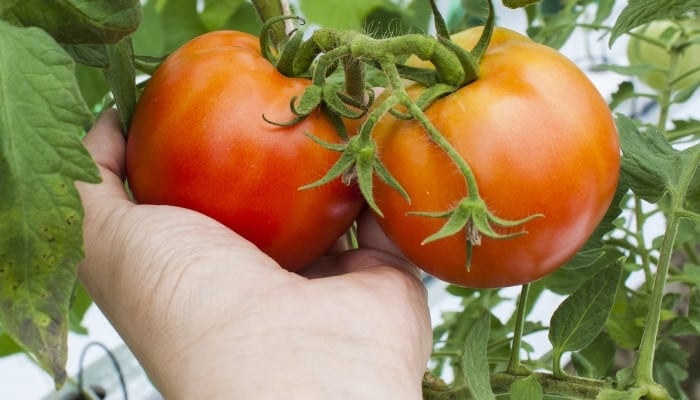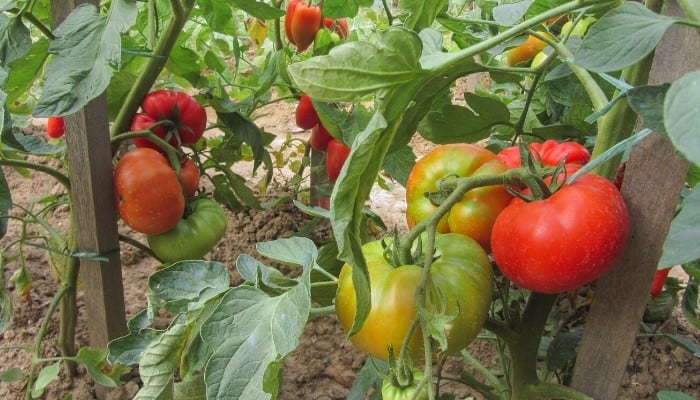Nothing compares to the flavor of homegrown tomatoes picked fresh from the vine. It becomes even more special when you gain knowledge about the journey it takes from being a seed to becoming a delightful addition to your plate.
When choosing to grow your tomatoes, the first thing you may be curious about is their life span.
How long can a tomato plant live? A tomato plant typically lives for one growing season (6-8 months) when grown outdoors, but when nurtured in ideal or controlled growing conditions indoors, tomato plants can survive between 2-5 years. Propagating healthy cuttings may also extend its life indefinitely.
It’s easy to forget that the common tomato is native to tropical South America and wasn’t made for phenomenal growth in milder climates.
However, this isn’t to say your homegrown tomato plant can’t prosper with enough effort. Let’s learn more about this plant’s life process, factors that hinder growth, and how to prolong its life.
Tomato Plant Life Span
In their journey from seed to fruit, tomato plants experience four growth stages, and their life span is determined by their specific variety, growing location, and the care afforded to them during each part of their cycle.
Tomato Plant Life Cycle
What Factors Trigger Tomato Plant Death
Unbalanced watering, lack of sunlight, and nutrient-poor soil can spell stunted growth and low-quality fruit while a combination of pest damage and subpar growing conditions can lead to a whole host of deadly diseases.
Founder of Gardening Know How Heather Rhoades advises that the soil should never be “cracked and dry nor swampy and standing in water” and that your tomato plant receives “at least five hours of daily sun.”
Additionally, pest numbers can be reduced with protective bird netting and companion planting while loamy, organic-rich soil can deliver adequate nutrients.
How Long Can a Tomato Plant Live in a Greenhouse?
Greenhouse-grown tomato plants can live between 3-5 years since they have year-round access to regulated temperatures and humidity as well as protection from direct sunlight and pests.
The warm, controlled climate also promotes better nutrient absorption from the soil and fertilizer.
How Long Can a Tomato Live Indoors?
Under ideal growing conditions, tomato plants may survive indoors for up to two growing seasons (2 years).
However, holder of a Plant Biochemistry & Soil Science degree at the University of South Wales, Gill Matthews warns:
“Growth will be leggy and straggly after the first year and indoor light will be insufficient to produce healthy fruit.”
How Long Can a Hydroponic Tomato Live?
Hydroponically grown tomatoes are grown in nutrient-rich water instead of soil and can last between 8-11 months, according to Upstart University in collaboration with developers of vertical farming technology.
Depending on the water quality used in the process, hydroponic tomato plants may live for as little as 6 months or as long as 2 years.
Don’t miss out on my full guide “Hydroponic Tomatoes 101” – learn everything you need to get started – it’s easier than you think!
How To Extend the Life of Tomato Plants

Successfully prolonging the life of your tomato plant hinges on three key factors:
- Providing an ideal growing environment from spring to frost.
- Dealing proactively with pest damage and disease.
- Harvesting the fruit at the perfect time.
Creating copies of your tomato plant through cuttings and growing beneficial companion plants are further ways to lengthen its life span.
Provide Ideal Growing Conditions
Tomato seeds germinate in 1-2 weeks given the ideal temperature range of 65-85°F and watered twice daily, while supplemental light (try these grow lights) can prevent spindly stems during leaf development.
From then on, transplanted tomato plants will prosper in 6-8 hours of full sunlight and soil with a 6.2-6.8 pH range.
They should also be watered enough to remain moist and fed with high-potassium fertilizer (I get great results with this tomato food) once flowering begins.
Plant Companion Plants for Tomatoes
Pairing certain plants up with your tomatoes can provide invaluable growth benefits from greater pest control to increased soil fertility. Here are a few to consider:
Remove Fruit Before Ripening Begins
Aim to harvest your tomatoes when they have turned from green to slightly pink.
This is what organic gardening educator and author Joe Lamp’l describes as “the breaker stage: once tomatoes appear ½ green ½ pink is when its stops taking nutrients from the plant and can be taken off the vine with no loss of flavor, quality, or nutrition.”
Fertilize Routinely
Look for plant food with an NPK (nitrogen-phosphorus-potassium) ratio of 18-18-21 such as Miracle-Gro Tomato Plant Food.
Soak the soil of your outdoor plant with a watering can solution of ½ tablespoon fertilizer and 1½ gallon water (or ½ teaspoon and 1½ gallon water for indoor potted plants).
Fertilize immediately after planting, and increase this to once every two weeks throughout the flowering and fruit-bearing stage.
Treat Pest & Disease Issues Immediately
Identifying troubling signs early enough on the fruit and foliage can save otherwise healthy crops. Mold patches and bug infestations can be treated on-site with garden fungicide or organic pesticide respectively.
Issues can be prevented in the long-term by watering at soil and not foliage level, using good-quality fertilizer to strengthen disease resistance, and rotating your crops every 2-3 years.
Root Tomato Cuttings
Help your tomato plant live on by taking healthy cuttings and rooting them in separate pots or “propagating” them.
Around May-June after producing the first cluster of healthy fruit, tomato plants send out side shoots that are often pruned to redirect growth to the developing fruit – but you can save these and root them in water using this simple method.
Bring Tomato Plants Indoors Before First Frost
You’ll need to shield it from the first hint of chilly weather to enjoy your plant for a second growing season.
Determine the first frost date in your area and once it is forecast, pull up the plant from the ground and transplant it into a pot.
Place it in a sheltered, bright location with the aid of grow lights (ideally in a greenhouse or garage) and with a microclimate of 65-85°F.
What Is the Lowest Temp a Tomato Plant Can Tolerate?
According to the US Department of Agricultural Research, tomato plants can survive temperatures down to 33°F and will succumb completely to frost below 32°F.
Any temperature below 50°F is problematic for tomato plants, preventing seeds from germinating and stunting growth in mature plants.
Cold-hardy varieties can tolerably produce fruit in low ranges of 50-60°F, but they will not thrive unless grown at 70°F and above.
When Should I Bring My Tomato Plants Inside?
Tomatoes are typically brought indoors at the end of summer or before the first signs of frost. This is normally when daytime temperatures outdoors are landing consistently below 60°F.
Urban Agriculturist Bonnie L. Grant advises overwintering your tomato plants in “unglazed clay pots as this allows them to breathe and improve soil aeration.”
Interested in branching out to aquaponics? Tomatoes are one of the best crops to grow with this method – learn the basics here.
Related Questions:
Do Tomatoes Grow Better in Pots or in the Ground?
According to Julie Martens Forney at Bonnie Plants, compact bush tomato plants (determinate varieties) thrive best in the loose, rich soil of container gardens, while taller, cordon tomatoes (indeterminate varieties) benefit from ground growth due to their extensive root systems.
What Does Epsom Salt Do for Tomatoes?
Epsom salt (magnesium sulfate) can be added to seedlings to help strengthen cell walls and improve nutrient intake from the soil.
It can also curb yellowing leaves that result from magnesium deficiency and be used as a foliar spray (learn more here) on mature plants to help promote larger juicer fruit.
Conclusion
To sum up, tomato plants live for one growing season on average, but this can vary depending on the level of care and unique growing culture, i.e., in homes, greenhouses, outdoors, or hydroponically.
A tomato plant’s life can be extended in many ways, including harvesting at the pre-ripened sweet spot, growing it with beneficial companion plants, and bringing them indoors before the frost sets in.

